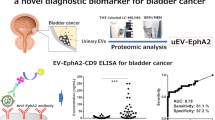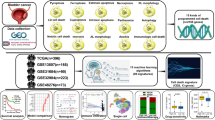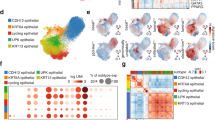Abstract
We studied E-cadherin down-regulation at the protein level in frozen sections of 111 bladder tumours and 13 normal bladder specimens by means of immunohistochemistry, and at the mRNA level by semi-quantitative RT-PCR in 40 of the same tumours. Results indicate that E-cadherin expression detected by immunohistochemistry correlated with both stage and grade (P < 0.0001 and P < 0.001, respectively). Analysis of recurrence, progression and survival over a mean period of 36 months after surgery in the entire cohort showed that abnormal E-cadherin immunoreactivity correlated strongly with poor outcome (log-rank test: P = 0.001, P = 0.0001 and P = 0.0003, respectively). In multistep logistic regression analysis, only E-cadherin status and stage had significant additional prognostic value (P = 0.008 and OR = 0.2; P = 0.03 and OR = 3.6, respectively). Survival estimates derived from RT-PCR transcript quantification differed significantly for low and high expression (log-rank test: P = 0.0006). These results suggest that the alteration occurs at the transcriptional level and support the clinical and biological relevance of cell adhesion molecules in bladder cancer. © 2000 Cancer Research Campaign
Similar content being viewed by others
Article PDF
Change history
16 November 2011
This paper was modified 12 months after initial publication to switch to Creative Commons licence terms, as noted at publication
References
Banks RE, Porter WH, Whelan P, Smith PH and Selby PJ (1995) Soluble forms of the adhesion molecule E-cadherin in urine. J Clin Pathol 48: 179–180
Behrens J (1994) Cell contacts, differentiation and invasiveness of epithelial cells. Invasion Metastasis 14: 61–70
Behrens J, Mareel MM, Van Roy FM and Birchmeier W (1989) Dissecting tumor cell invasion: epithelial cells acquire invasive properties after the loss of uvomorulin-mediated cell–cell adhesion. J Cell Biol 108: 2435–2447
Bringuier PP, Umbas R, Schaafsma HE, Karthaus HFM, Debruyne FMJ and Schalken JA (1993) Decreased E-cadherin immunoreactivity correlates with poor survival in patients with bladder tumors. Cancer Res 53: 3241–3245
Chirgwin JM, Przybyla AE, Mac Donald RJ and Rutter WJ (1979) Isolation of biologically active ribonucleic acid from sources enriched in ribonuclease. Biochemistry 18: 5294–5299
Frixen UH, Behrens J, Sachs M, Eberle G, Voss B, Warda A, Löchner D and Birchmeier W (1991) E-cadherin-mediated cell–cell adhesion prevents invasiveness of human carcinoma cells. J Cell Biol 113: 173–185
Gil-Diez de Medina S, Chopin DK, El Marjou A, Delouvée A, La Rochelle WJ, Hoznek A, Abbou CC, Aaronson SA, Thiery JP and Radvanyi F (1997) Decreased expression of keratinocyte growth factor receptor in a subset of human transitional cell bladder carcinomas. Oncogene 14: 323–330
Gil-Diez de Medina S, Popov Z, Chopin DK, Southgate J, Tucker GC, Delouvée A, Thiery JP and Radvanyi F (2000) Relationship between E-cadherin and fibroblast growth factor receptor 2b expression in bladder carcinomas. Oncogene 18: 5722–5726
Giroldi LA, Bringuier PP and Schalken JA (1994) Defective E-cadherin function in urological cancers: clinical implications and molecular mechanisms. Invasion Metastasis 14: 71–81
Giroldi LA, Bringuier PP, Shimazui T, Jansen K and Schalken JA (2000) Changes in cadherin–catenin complexes in the progression of human bladder carcinoma. Int J Cancer 2: 70–76
Graff JR, Herman JG, Lapidus RG, Chopra H, Xu R, Jarrad DF, Isaacs WB, Pitha PM, Davidson NE and Baylin SB (1995) E-cadherin expression is silenced by DNA hypermethylation in human breast and prostate carcinomas. Cancer Res 55: 5195–5199
Griffiths TR, Brotherick I, Bishop RI, White MD, Mc Kenna DM, Horne CW, Shenton BK, Neal DE and Mellon JK (1996) Cell adhesion molecules in bladder cancer: soluble serum E-cadherin correlates with predictors of recurrence. Br J Cancer 74: 579–584
Herr HW, Badalament RA, Amato DA, Laudone VP, Fair WR Jr and Whitmore WF (1989) Superficial bladder cancer treated with bacillus Calmette–Guerin: a multivariate analysis of factors affecting tumor progression. J Urol 141: 22–29
Imao T, Koshida K, Endo Y, Uchibayashi T, Sasaki T and Namiki M (2000) Dominant role of E-cadherin in the progression of bladder cancer. J Urol 161: 692–698
Knowles MA, Elder PA, Williamson M, Cairns JP, Shaw ME and Law MG (1994) Allelotype of human bladder cancer. Cancer Res 54: 531–538
Liotta LA, Steeg PS and Stetler-Stevenson WG (1991) Cancer metastasis and angiogenesis: an imbalance of positive and negative regulation. Cell 64: 327–336
Lipponen PK and Eskelinen MJ (1995) Reduced expression of E-cadherin is related to invasive disease and frequent recurrence in bladder cancer. J Cancer Res Clin Oncol 121: 303–308
Mareel MM, Behrens J, Birchmeier W, De Bruyne GK, Vleminckx K, Hoogewijs A, Fiers WC and Van Roy FM (1991) Down-regulation of E-cadherin expression in Madin–Darby canine kidney (MDCK) cells inside tumors of nude mice. Int J Cancer 47: 922–928
McNeill H, Ozawa M, Kemler R and Nelson WJ (1990) Novel function of the cell adhesion molecule uvomorulin as an inducer of cell surface polarity. Cell 62: 309–316
Nagafuchi A, Shirayoshi Y, Okazaki K, Yasuda K and Takeichi M (1987) Transformation of cell adhesion properties by exogenously introduced E-cadherin cDNA. Nature 329: 341–343
Oka H, Shiozaki H, Kobayashi K, Inoue M, Tahara H, Kobayashi T, Takatsuka Y, Matsuyoshi N, Hirano S, Takeichi M and Mori T (1993) Expression of E-cadherin cell adhesion molecules in human breast cancer tissues and its relationship to metastasis. Cancer Res 53: 1696–1701
Otto T, Rembrink K, Goepel M, Meyer Schwickerath M and Rübben H (1993) E-cadherin: a marker for differentiation and invasiveness in prostatic carcinoma. Urol Res 21: 359–362
Otto T, Bex A, Schmidt U, Raz A and Rübben H (1997) Improved prognosis assessment for patients with bladder carcinoma. J Pathol 150: 1919–1923
Ozawa M, Ringwald M and Kemler K (1990) Uvomorulin–catenin complex formation is regulated by a specific domain in the cytoplasmic region of the cell adhesion molecule. Proc Natl Acad Sci USA 87: 4246–4250
Raghavan D, Shipley WU, Garnick MB, Russell PJ and Richie JP (1990) Biology and management of bladder cancer. N Engl J Med 322: 1129–1138
Rebel JM, Thijssen CD, Vermey M, Delouvée A, Zwarthoff EC and Van Der Kwast TH (1994) E-cadherin expression determines the mode of replacement of normal urothelium by human bladder carcinoma cells. Cancer Res 54: 5488–5492
Ross JS, Del Rosario AD, Figge HL, Sheehan C, Fisher H’A and Bui HX (1995) E-cadherin expression in papillary transitional cell carcinoma of the urinary bladder. Hum Pathol 26: 940–944
Ruijter ET, Miller GJ, Aalders TW, Van de Kaa CA, Schalken JA, Debruyne FM and Boon ME (1997) Rapid microwave-stimulated fixation of entire prostatectomy specimens. Biomed-II MPC Study Group. J Pathol 183: 369–375
Schipper JH, Frixen UH, Behrens J, Unger A, Jahnke K and Birchmeier W (1991) Ecadherin expression in squamous cell carcinomas of head and neck: inverse correlation with tumor dedifferentiation and lymph node metastasis. Cancer Res 51: 6328–6337
Shimazui T, Schalken JA, Giroldi LA, Jansen CF, Akasa H, Koiso Debruyne FM and Bringuier PP (1996) Prognostic value of cadherin-associated molecules (alpha-, beta, and gamma-catenins and p120cas) in bladder tumors. Cancer Res 56: 4154–4158
Shimoyama Y and Hirohashi S (1991) Expression of E-cadherin and P-cadherin in gastric carcinomas. Cancer Res 51: 2185–2192
Shimoyama Y, Hirohashi S, Hirano S, Noguchi M, Shimosato Y, Takeichi M and Abe O (1989) Cadherin cell-adhesion molecules in human epithelial tissues and carcinomas. Cancer Res 49: 2128–2133
Shiozaki H, Tahara H, Oka H, Miyata M, Kobayashi K, Tamura S, Iihara K, Doki Y, Hirano S, Takeichi M and Mori T (1991) Expression of immunoreactive E-cadherin adhesion molecules in human cancers. Am J Pathol 139: 17–23
Syrigos KN, Krausz T, Waxman J, Pandha H, Rowlinson-Busza G, Verne J, Epenetos AA and Pignatelli M (1995) E-cadherin expression in bladder cancer using formalin-fixed paraffin-embedded tissues: correlation with histopathological grade, tumour stage and survival. Int J Cancer 64: 367–370
Syrigos KN, Harrington K, Waxman J, Krausz T and Pignatelli M (1998) Altered gamma-catenin expression correlates with poor survival in patients with bladder cancer. J Urol 160: 1889–1893
Takeichi M (1991) Cadherin cell adhesion receptors as a morphogenetic regulator. Science 251: 1451–1455
Takeichi M (1993) Cadherins in cancer: implications for invasion and metastasis. Curr Opin Cell Biol 5: 806–811
Umbas R, Schalken JA, Aalders TW, Carter BS, Karthaus HF, Schaafsma HE, Debruyne FMJ and Isaacs WB (1992) Expression of the cellular adhesion molecule E-cadherin is reduced or absent in high-grade prostate cancer. Cancer Res 52: 5104–5109
Vleminckx K, Vakaet L Jr, Mareel M, Fiers W and Van Roy F (1991) Genetic manipulation of E-cadherin expression by epithelial tumor cells reveals an invasion suppressor role. Cell 66: 107–119
Author information
Authors and Affiliations
Rights and permissions
From twelve months after its original publication, this work is licensed under the Creative Commons Attribution-NonCommercial-Share Alike 3.0 Unported License. To view a copy of this license, visit http://creativecommons.org/licenses/by-nc-sa/3.0/
About this article
Cite this article
Popov, Z., Medina, SD., Lefrere-Belda, MA. et al. Low E-cadherin expression in bladder cancer at the transcriptional and protein level provides prognostic information. Br J Cancer 83, 209–214 (2000). https://doi.org/10.1054/bjoc.2000.1233
Received:
Revised:
Accepted:
Published:
Issue date:
DOI: https://doi.org/10.1054/bjoc.2000.1233
Keywords
This article is cited by
-
Ketamine-induced urological toxicity: potential mechanisms and translation for adults with mood disorders receiving ketamine treatment
Psychopharmacology (2021)
-
CLASP2 is involved in the EMT and early progression after transurethral resection of the bladder tumor
BMC Cancer (2017)
-
Expression de l’E-cadhérine et de la β-caténine dans les tumeurs urothéliales de la vessie de stade pTa/pT1
Journal Africain du Cancer / African Journal of Cancer (2011)
-
Epigenetics in bladder cancer
International Journal of Clinical Oncology (2008)
-
Einsatz der Siliziumchiptechnologie zur Detektion von Tumormarkern auf Proteinbasis beim Harnblasenkarzinom
Der Urologe (2007)



